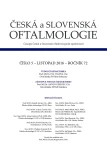Blepharophimosis-ptosis-epicanthus inversus syndrome
Authors:
P. Lišková 1,2; Ľ. Ďuďáková 2; P. Diblík 1
Authors‘ workplace:
Oční klinika, 1. lékařská fakulta, Univerzita Karlova v Praze a Všeobecná fakultní nemocnice v Praze přednosta: doc. MUDr. Jarmila Heissigerová, Ph. D., MBA
1; Ústav dědičných metabolických poruch, 1. lékařská fakulta, Univerzita Karlova v Praze a Všeobecná fakultní nemocnice, Praha, přednosta prof. MUDr. Viktor Kožich, CSc.
2
Published in:
Čes. a slov. Oftal., 72, 2016, No. 5, p. 187-190
Category:
Original Article
Overview
Purpose:
To report the ocular phenotype of blepharophimosis-ptosis-epicanthus inversus syndrome (BPES).
Methods:
Ophthalmological examination of a 36 year-old proband and detailed family history evaluation, including assessment of available facial photographs of affected relatives, was performed.
Results:
There were four affected males and one female in three generations. The proband underwent two surgical eyelid procedures in childhood. Upon our examination, he had symmetrical ptosis with shorter eye lids, and incomplete medial canthal closure. The skin in the inner canthi was scarred, and the medial lower lids slightly everted, leading to malapposition of lacrimal punctae. There was no epicanthus inversus, however it was impossible to determine the status prior to the eyelid surgeries. The best corrected visual acuity was 0.66 and 0.33, in the right and left eye, respectively. The rest of the ocular examination was normal. There was no strabismus. Based on inspection of photographs taken prior to eyelid surgeries, the typical signs of BPES were also present in a son and a nephew of the proband. Photographs of the affected brother were not available, but family history indicated that he had BPES and underwent in his childhood two eye lid surgeries. Atypical ocular phenotype of the proband’s mother has been published previously.
Conclusions:
Ophthalmologists need to be aware about the phenotype of BPES, with the potential for visual impairment, and the need for personalized management in the affected families.
Key words:
blepharophimosis-ptosis-epicanthus inversus, phenotype, FOXL2
Sources
1. Beckingsale, PS., Sullivan, TJ., Wong, VA., et al.: Blepharophimosis: a recommendation for early surgery in patients with severe ptosis. Clin Experiment Ophthalmol, 31(2); 2003: 138–142.
2. Bhattacharjee, K., Bhattacharjee, H., Kuri, G., et al.: Single stage surgery for Blepharophimosis syndrome. Indian J Ophthalmol, 60(3); 2012: 195–201.
3. Beysen, D., De Paepe, A., De Baere, E.: FOXL2 mutations and genomic rearrangements in BPES. Hum Mutat, 30(2); 2009: 158–169.
4. Beysen, D., Raes, J., Leroy, BP., et al.: Deletions involving long-range conserved nongenic sequences upstream and downstream of FOXL2 as a novel disease-causing mechanism in blepharophimosis syndrome. Am J Hum Genet, 77(2); 2005: 205–218.
5. De Baere, E., Dixon, MJ., Small, KW., et al.: Spectrum of FOXL2 gene mutations in blepharophimosis-ptosis-epicanthus inversus (BPES) families demonstrates a genotype--phenotype correlation. Hum Mol Genet, 10(15); 2001: 1591–1600.
6. De Baere, E., Beysen, D., Oley, C., et al.: FOXL2 and BPES: mutational hotspots, phenotypic variability, and revision of the genotype-phenotype correlation. Am J Hum Genet, 72(2); 2003: 478–487.
7. De Rycke, M., Belva, F., Goossens, V., et al.: ESHRE PGD Consortium data collection XIII: cycles from January to December 2010 with pregnancy follow-up to October 2011. Hum Reprod, 30(8); 2015: 1763–1789.
8. D’Haene, B., Nevado, J., Pugeat, M., et al.: FOXL2 copy number changes in the molecular pathogenesis of BPES: unique cohort of 17 deletions. Hum Mutat, 31(5); 2010: E1332–1347.
9. Haghighi, A., Verdin, H., Haghighi-Kakhki, H., et al.: Missense mutation outside the forkhead domain of FOXL2 causes a severe form of BPES type II. Mol Vis, 18; 2012: 211–218.
10. Karacaoglan, N., Sahin, U., Ercan, U., et al.: One-stage repair of blepharophimosis: a new method. Plast Reconstr Surg, 93(7); 1994: 1406–1409.
11. Krepelova, A., Simandlova, M., Vlckova, M., et al.: Analysis of FOXL2 detects three novel mutations and an atypical phenotype of blepharophimosis-ptosis-epicanthus inversus syndrome. Clinical and Experimental Ophthalmology, 2016; v tisku.
12. Mustarde, JC.: Epicanthus and Telecanthus. Br J Plast Surg, 16; 1963: 346–356.
13. Nakajima, T., Yoshimura, Y., Onishi, K., et al.: One-stage repair of blepharophimosis. Plast Reconstr Surg, 87(1); 1991: 24–31.
14. Oley, C., Baraitser, M.: Blepharophimosis, ptosis, epicanthus inversus syndrome (BPES syndrome). J Med Genet, 25(1); 1988: 47–51.
15. Otradovec, J.: Ptózy a pseudoptózy. In Ortrádovec, J., Klinicka neurooftalmologie. Praha: GRADA, 2003, s. 320–325.
16. Tronina, SA., Bobrova, NF., Khrinenko, VP.: Clinical and anatomical substantiation of levator resection in the complex surgical treatment of BPES. Orbit, 25(1); 2006: 5–10.
17. Zlotogora, J., Sagi, M., Cohen, T.: The blepharophimosis, ptosis, and epicanthus inversus syndrome: delineation of two types. Am J Hum Genet, 35(5); 1983: 1020–1027.
Labels
OphthalmologyArticle was published in
Czech and Slovak Ophthalmology

2016 Issue 5
Most read in this issue
- Blepharophimosis-ptosis-epicanthus inversus syndrome
- Iris melanoma in a child
- Preimplantation genetic diagnosis and monogenic inherited eye diseases
- The Tear Osmolarity of PATIENTS with Lagophthalmos
